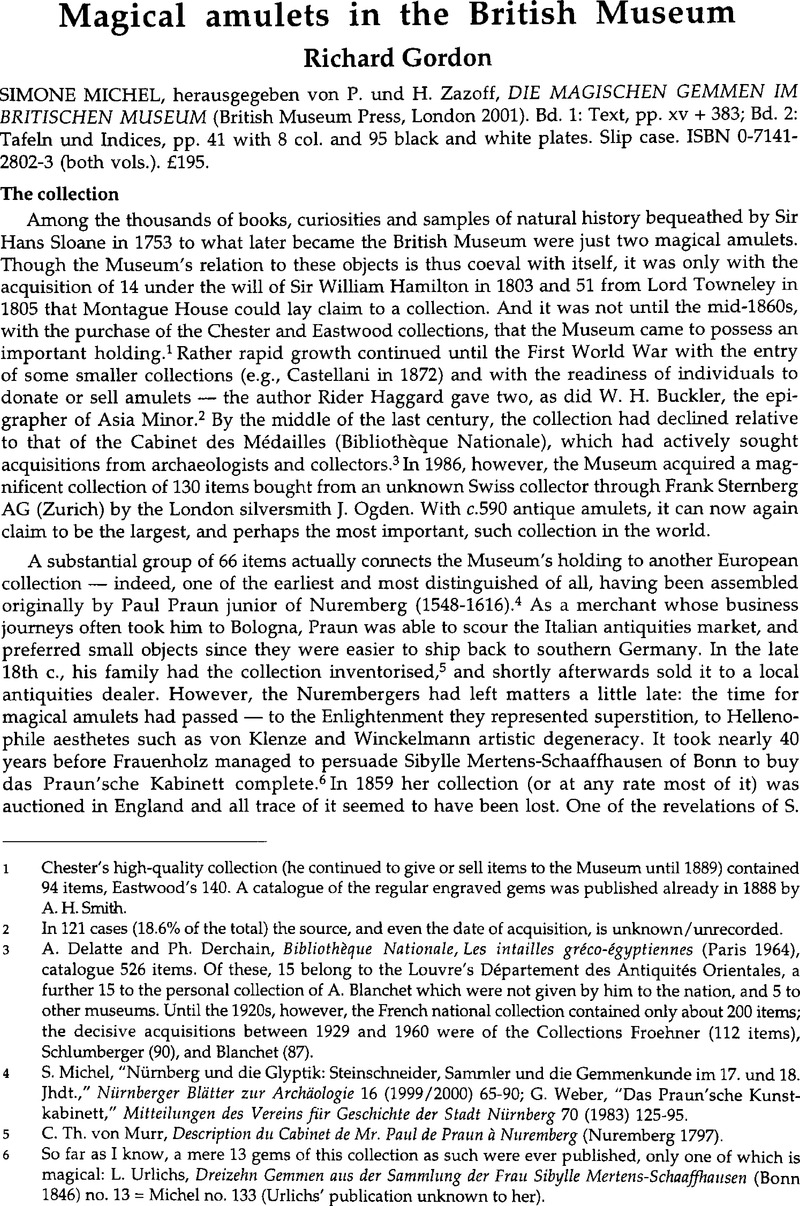No CrossRef data available.
Article contents
Magical amulets in the British Museum - Simone Michel, von P. herausgegeben und H. Zazoff, DIE MAGISCHEN GEMMEN IM BRITISCHEN MUSEUM (British Museum Press, London 2001). Bd. 1: Text, pp. xv + 383; Bd. 2: Tafeln und Indices, pp. 41 with 8 col. and 95 black and white plates. Slip case. ISBN 0-7141-2802-3 (both vols.). £195.
Published online by Cambridge University Press: 16 February 2015
Abstract

- Type
- Reviews
- Information
- Copyright
- Copyright © Journal of Roman Archaeology L.L.C. 2002
References
1 Chester's high-quality collection (he continued to give or sell items to the Museum until 1889) contained 94 items, Eastwood's 140. A catalogue of the regular engraved gems was published already in 1888 by A. H. Smith.
2 In 121 cases (18.6% of the total) the source, and even the date of acquisition, is unknown/unrecorded.
3 Delatte, A. and Derchain, Ph., Bibliothèque Nationale, Les intailles gréco-égyptiennes (Paris 1964), catalogue 526 itemsGoogle Scholar. Of these, 15 belong to the Louvre's Département des Antiquités Orientales, a further 15 to the personal collection of A. Blanchet which were not given by him to the nation, and 5 to other museums. Until the 1920s, however, the French national collection contained only about 200 items; the decisive acquisitions between 1929 and 1960 were of the Collections Froehner (112 items), Schlumberger (90), and Blanchet (87).
4 Michel, S., “Nürnberg und die Glyptik: Steinschneider, Sammler und die Gemmenkunde im 17. und 18. Jhdt,” Nürnberger Blätter zur Archäologie 16 (1999/2000) 65–90 Google Scholar; Weber, G., “Das Praun'sche Kunstkabinett,” Mitteilungen des Vereins für Geschichte der Stadt Nürnberg 70 (1983) 125–95Google Scholar.
5 von Murr, C. Th., Description du Cabinet de Mr. Paul de Praun à Nuremberg (Nuremberg 1797)Google Scholar.
6 So far as I know, a mere 13 gems of this collection as such were ever published, only one of which is magical: Urlichs, L., Dreizehn Gemmen aus der Sammlung der Frau Sibylle Mertens-Schaaffhausen (Bonn 1846)Google Scholar no. 13 = Michel no. 133 (Urlichs' publication unknown to her).
7 This brief account is put together from D. Buckton's preface (vii), and private information from S. Michel, D. Buckton and T. Francis of the British Museum Press.
8 E.g., King, C. W., The Gnostics and their remains, ancient and medieval (1st edn. London 1864, 2nd 1887)Google Scholar.
9 C. Bonner included only 12 gems from the British Museum in Studies in magical amulets, chiefly Graeco-Egyptian (Ann Arbor 1950)Google Scholar, and a larger selection in “Amulets chiefly in the British Museum,” Hesperia 20 (1951) 301–45CrossRefGoogle Scholar, but he never visited the Museum and knew the gems only from photos of plaster-casts, as was then usual. According to my count, 239 (about 40%) of the gems published here, exclusive of modern imitations, are wholly unpublished. A further 46 items, all from the Ogden collection, were first published (or cited) only very recently, 34 by Michel herself in “Medizinisch-magische Amulettgemmen. Schutz und Heilung durch Zauber und edle Steine in der Antike,” AntW 26.5 (1995) 379–87Google Scholar, and 12 by Walter, C., “Some unpublished intaglios of Solomon in the British Museum,” ΘΥΜΙΑΜΑ (1994) 365–68, pl. 34 (pp. 205-6)Google Scholar.
10 Not all were brought together: the Department of Prehistoric and Early Europe.was unwilling to release its magical gems, and they are not covered in the catalogue.
11 Smith, M., “Old Testament motifs in the iconography of the British Museum's magical gems,” in Casson, L. (ed.), Coins, culture and history in the ancient world: Numismatic, studies for Bluma Trell (Detroit 1981) 187–94Google Scholar.
12 Where possible, these notes have been incorporated into the catalogue and marked ‘M. Smith’.
13 Goodenough, E. R., Jewish symbols in the Greco-Roman period vol. 2 (Toronto 1953) 208–95Google Scholar, stressing the Judaic contribution to the Graeco-Egyptian magical papyri. Derchain, who was an Egyptologist, regretted that he had not been able to consult an expert on ancient Judaism during work on the Paris catalogue: Les intailles (supra n.3) 10 n.1. Nagy's article in this issue, which I refer to again below, lends renewed support to the claim.
14 The Zazoffs also commented on her entries as she wrote them and assisted with proof-reading.
15 Die magischen Gemmen. Eine Studie zu Zauberformeln und magischen Bildern auf geschnittenen Steinen der Antike und Neuzeit (Gießen 1997)Google Scholar. The Aby Warburg Stiftung awarded her the Hans Reimers prize for 2001 in recognition of her work on the catalogue.
16 Zazoff, P., “Vorwort der Herausgeber,” xi Google Scholar. He had also written the standard handbook on ancient gems: Die antiken Gemmen (Munich 1983)Google Scholar.
17 So also Zwierlein-Diehl, E., Magische Amulette und andere Gemmen des Instituts für Altertumskunde der Universität zu Köln (Opladen 1992)Google Scholar, an exemplary publication of a small collection.
18 Mira et magica. Gemmen im Ägyptischen Museum der Staatlichen Museen, Preußischer Kulturbesitz, Berlin-Charlottenburg (Mainz 1986)Google Scholar.
19 They occur mainly in the Greek: e.g., nos. 24, 25, 499, 543.
20 F. M., and Schwartz, J. H., “Engraved gems in the collection of the American Numismatic Society, 1: ancient magical amulets,” ANSMN 24 (1979) 157–59Google Scholar, picking up a suggestion by A. A. Barb.
21 Zwierlein-Diehl (supra n.17) 30-31; she owed the point to R. Merkelbach.
22 Philonenko, M. M., “L'anguipède alectorocéphale et le dieu IAO,” CRAI 1979, 297–304 CrossRefGoogle Scholar.
23 As is done by Zwierlein-Diehl (supra n.17). Michel follows Philipp here, whose bibliographical references are much less full; but there may also have been a question of cost and lay-out.
24 See Bonner, Studies (supra n.9) 66-67.
25 These pieces are asterisked only in the plates section.




